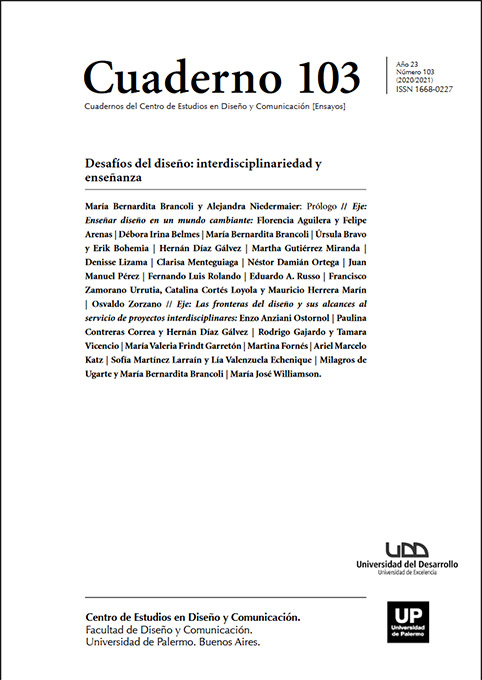Sustentabilidad del patrimonio inmaterial, relevando el valor del territorio mediante redes colaborativas de diseño y manufactura
Abstract
A clear opportunity for design to participate and enhance the value of intangible heritage has been, countless times, approached from the collaborative integration of artisanal production. Those who inhabit a given territory and have common interests, tend to enhance their development by grouping with others oriented to similar economic and social objectives. However, productivity levels demanded by the market are often incompatible with the reality of the craftsman and their limited, slow and hardly scalable production.
To fulfill these expectations, especially of persons, the craftsmanship and its territory try to build collaborative cultures of responsibility, which are easily accepted by a consumer aware and avid of local identity rooted in the territory. But it is precisely this value, of territory and its distances, what does not allow the development of the whole system, fragmenting the result and deepening the uprooting of identity.
Nevertheless, it is plausible that design builds and participates in models of collaborative networks distributed virtually in the territory, integrating digital manufacturing and Information Technology, without affecting the resulting craft, nor the capacity of adaptation, flexibility and independence of the craftsman, respecting the tradition of local and autonomous production.
...Those who inhabit a given territory and have common interests, tend to enhance their development through grouping oriented to similar economic and social objectives, the so-called clusters, which are “ closed organizations of common interests associated to a specific territory by economic benefits” (Botti & Giret, 2008; Porter, 1998), that have been developed and successfully scaled within the mass production model.
References
Alonso, G.; Medici, M.; Nowacka, K.; Steinlage, M. & Cohen, G. (2014). Indicadores UNESCO de Cultura para el Desarrollo: Manual Metodológico, París: Organización de las Naciones Unidas para la Educación, la Ciencia y la Cultura.
Bauman, Z. (2004). Modernidad líquida (M. Rosenberg, Trans.) (2003rd ed.), Buenos Aires: Fondo de Cultura Económica Argentina.
Botti, V. & Giret, A. (2008). ANEMONA. Springer Science & Business Media. http://doi.org/10.1007/978-1-84800-310-1
Carter, A. C. (2013, August 3). Mass-customization through digital manufacturing. (R. Britnell, T.-M. Lau, B. Smith, & C. Arnold, Eds.). Auburn, Alabama.
Dini, M. & Stumpo, G. (2011). Políticas para la innovación en las pequeñas y medianas empresas en América Latina. Comisión Económica para América Latina y el Caribe.
Katz, R. (2015). El ecosistema y la economía digital en América Latina, Madrid: Fundación Telefónica, Editorial Ariel, CEPAL, 2015.
Kocatürk, T. & Medjdoub, B. (2011). Distributed Intelligence in Design. John Wiley & Sons. Disponible en www.wiley.com/wiley-blackwell
Kotler, P. (1989) “From mass marketing to mass customization” en Planning Review 17(5). http://doi.org/10.1108/eb054267
Kotler, P.; Kartajaya, J. & Setiawan, I. (2013). Marketing 3.0.
Lipovetsky, G. & Moya, A. P. (2007). La felicidad paradójica: ensayo sobre la sociedad de hiperconsumo, Barcelona: Anagrama.
MacDougall, W. (2016). Industrie 4.0. Germany Trade and Invest Gesellschaft für Außenwirtschaft und Standortmarketing mbH.
Maffei, S. (2003). Design e distretti industriali: contesto territoriale ed apprendimento collettivo situato, (62).
Moller, C. (2016, March 24). Industrial Manufacturing Trends To Watch In 2016, disponible en http://blog.mixerdirect.com/industrial-manufacturing-trends-to-watch-in-2016. Consultado el 17 de julio de 2016.
Pine, B. J. & Gilmore, J. H. (2000). La economía de la experiencia, Barcelona: Granica.
Porter, M. E. (1998). Clusters and Competition New Agendas for Companies, Governments, and Institutions. Citeseer.
Prahalad, C. K. & Ramaswamy, V. (2004). “The future of competition, Co-creating unique value with customers” en Strategy & Leadership 32(3), 4-9. http://doi.org/10.1108/10878570410699249
Salvador, F.; De Holan, P. M. & Piller, F. (2009). “Cracking the Code of Mass Customization” en MIT Sloan Management Review 50(3).
Sniderman, B.; Mahto, M. & Cotteleer, M. J. (2016). “Industry 4.0 and manufacturing ecosystems” en Deloitte Review, 1-28.
Los autores/as que publiquen en esta revista ceden los derechos de autor y de publicación a "Cuadernos del Centro de Estudios de Diseño y Comunicación", Aceptando el registro de su trabajo bajo una licencia de atribución de Creative Commons, que permite a terceros utilizar lo publicado siempre que de el crédito pertinente a los autores y a esta revista.


